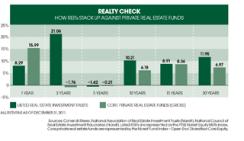At first glance, choosing publicly traded real estate investment trusts over the private competition looks like a no-brainer. Created in 1960 to give mainstream investors access to highbrow commercial property investments then controlled by America’s richest families, REITs have beaten private funds by almost 5 percent a year over the past three decades.
But that’s not enough to lure pension funds, endowments and other institutional investors, which still keep about 80 percent of their real estate allocations in illiquid private real estate funds, according to many investment consultants. Among the reasons for choosing private investments: concerns about pricing and volatility. Because REITs are listed products, their prices fluctuate throughout the trading day. Holdings in private real estate funds are valued quarterly at best, removing the perceived volatility.
Robert Steers, co-founder of New York–based REIT giant Cohen & Steers, says investors favor funds that lock up their money even though they aren’t earning anything extra — the so-called illiquidity premium. “Sophisticated investors are essentially saying, ‘Because it’s not being priced daily, it’s less volatile,’?” explains Steers, whose firm manages $49.3 billion in assets.
In a REIT or a private real estate fund, comparable underlying commercial office buildings or apartment complexes are worth the same. Cohen & Steers’ proprietary research finds that investors should earn a 300-basis-point illiquidity premium for locked-up capital held by private real estate funds. For the 30 years through December 2011, though, listed REITs returned an average of 11.95 percent annually, compared with core private real estate funds’ 6.97 percent.

The 2008–’09 financial crisis highlighted the illiquidity of private real estate funds when investors couldn’t access their capital; many institutions have since shifted some investments to REITs, which are easy to trade. But correlations between REITs and the broader equity market skyrocketed during the crisis. “That wasn’t how it was supposed to happen,” says Adrianna Giesey, a San Diego–based research analyst at consulting firm and asset manager Russell Investments. “But REITs got lumped in with banking and financial stocks and were sold off with these holdings.” Russell typically recommends that institutions have about 80 percent of their real estate allocation in funds and direct real estate, with the rest in REITs.
Eighty percent of the Oregon Public Employees Retirement Fund’s real estate assets are in private vehicles. But the $59 billion, Tigard-based fund has been growing its allocation to public REITs for 12 years, says real estate investment officer Anthony Breault. For example, Cohen & Steers manages a customized strategy of regional mall REITs on its behalf. Fairfax County Retirement Systems gets its real estate exposure primarily through REITs, partly for the liquidity advantages but also because as a smaller pension operation it finds REITs easier to access than private funds. Laurnz (Larry) Swartz, CIO of the $5.8 billion, Fairfax, Virginia–based system, says investors still don’t fully embrace REITs because of their volatility. Given that quality, consultants have long wanted to classify Fairfax County’s REITs as part of the system’s equity allocation, Swartz notes. REITs still make up most of its real estate allocation.
Eventually, REITs may prevail. “Over time the performance record will generate more and more interest from institutions,” predicts Steven Wechsler, president and CEO of the Washington-based National Association of Real Estate Investment Trusts. Green Street’s Kirby calls each new convert a big win. “It’s hand-to-hand combat,” he says.







